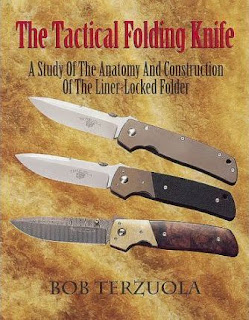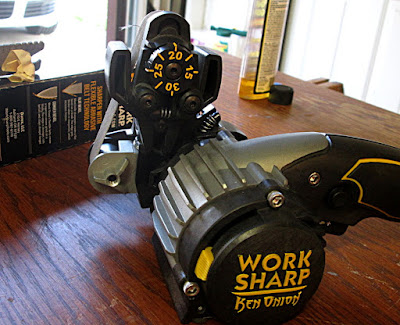By now most people realize that descriptive words don’t mean
anything, or rather mean only what the author would like them to mean. One author I’ve been reading describes men’s
aftershave as “peppery” whatever that means.
Knives are a similar situation. Editors and authors will agree that it’s a
folding knife, but is it a jack knife, pocket knife or the mysterious tactical
knife?
Almost everyone will agree on the following definitions:
Slip joint folder:
This is the simplest of folding knives.
Friction between the blade and bolster holds the knife open. Early Roman knives were like this. I suspect you needed to hold the blade’s
spine pinched between thumb and index finger to use the blade. A step up would be the 16 century peasant
knife in which a metal tang would fold against the back of the handle when open
and your grasp would keep the knife open.
Friction folders:
These use a spring, sometimes called a back spring to maintain pressure
on the blade to keep it open or closed.
These are very common today.
Locking or Clasp folder:
Knives in this category use a mechanism that actively prevents the blade
from closing until that mechanism is altered to release the blade. These have morphed into the term “tactical”
which means they cost more.
Once we get past these basics we start creating new
descriptors of knives.
I recently pick up a… well, I’m not sure what to call it.
It’s a gent’s knife, which means it’s largely a vest pocket
toy carried for only the most superficial cutting tasks. This term is often applied to small knives
worn on a watch chain or carried just to trim loose threads, file a torn fingernail
or cut a bag of potato chips open.
The term has been upgraded by vendors like A. G. Russell to
include higher quality locking knives.
 |
| My new lobster style knife |
This one has steel blades in a brass handle, so you know
it’s not designed for heavy work as brass is not the strongest material
available. It is decorated nicely with
raised surfaces and dark black designs.
Some gent’s knives use precious and semi-precious materials like gold,
ivory, exotic stone and tropical woods as well as steel for a handle.
This one is decorated in what is described on the internet
as Toledo style, even though it has no connection to Ohio or Spain. There are three tools in this knife, a large
blade, a smaller one on one side, and folding scissors on the other side.
The spring is in the center of the handle where it tensions
all three tools. One end appears to
forked, giving the smaller blade and scissors the needed spring force.
 |
| I guess it resembles a lobster, maybe? |
The pattern or artistic style, for lack of a better name, is
a lobster. Since two of the tools open
on the same end, but opposite side, if you look at it from the right angle,
close one eye and squint with the other, you might find some passing resemblance
to a lobster with its two claws.
You might describe this knife as a Toledo lobster gent’s
knife.
The handle is composed of two thin sheets of brass. It has a gold color so I suspect it’s coated
with a dyed lacquer. It was a common
occurrence with the old brass microscopes.
Different lots of brass would have different colors, so manufacturers lacquered
the scope to give it a uniform colour appearance. Very common with English microscopes.
 |
| Fine detail of brushed surface The marker bar is 5mm or half a centimeter |
The handles aren’t scratched, but brushed to give the brass
a softer look. Again it’s attempting to
pass as gold or at least golden.
 |
| Inox means stainless steel |
The blades are marked “Inox, Solingen, Germany”, but that
doesn’t mean the knife was made there. I
couldn’t find any other marks or identification on the knife. This suggests that is was a low quality
product made by jobbers.
Still, I like the darn thing. The handle is in a relatively undamaged
condition, and I like the pattern on the brass handle as well as the proportions
of the handle. The two blades are clean with
original edges and the scissors looks nice.
Unfortunately there are no compelling reasons for knife manufacturers
to set down and hammer out descriptions the industry would use. So, until they do, I have a Toledo lobster
gent’s knife.




